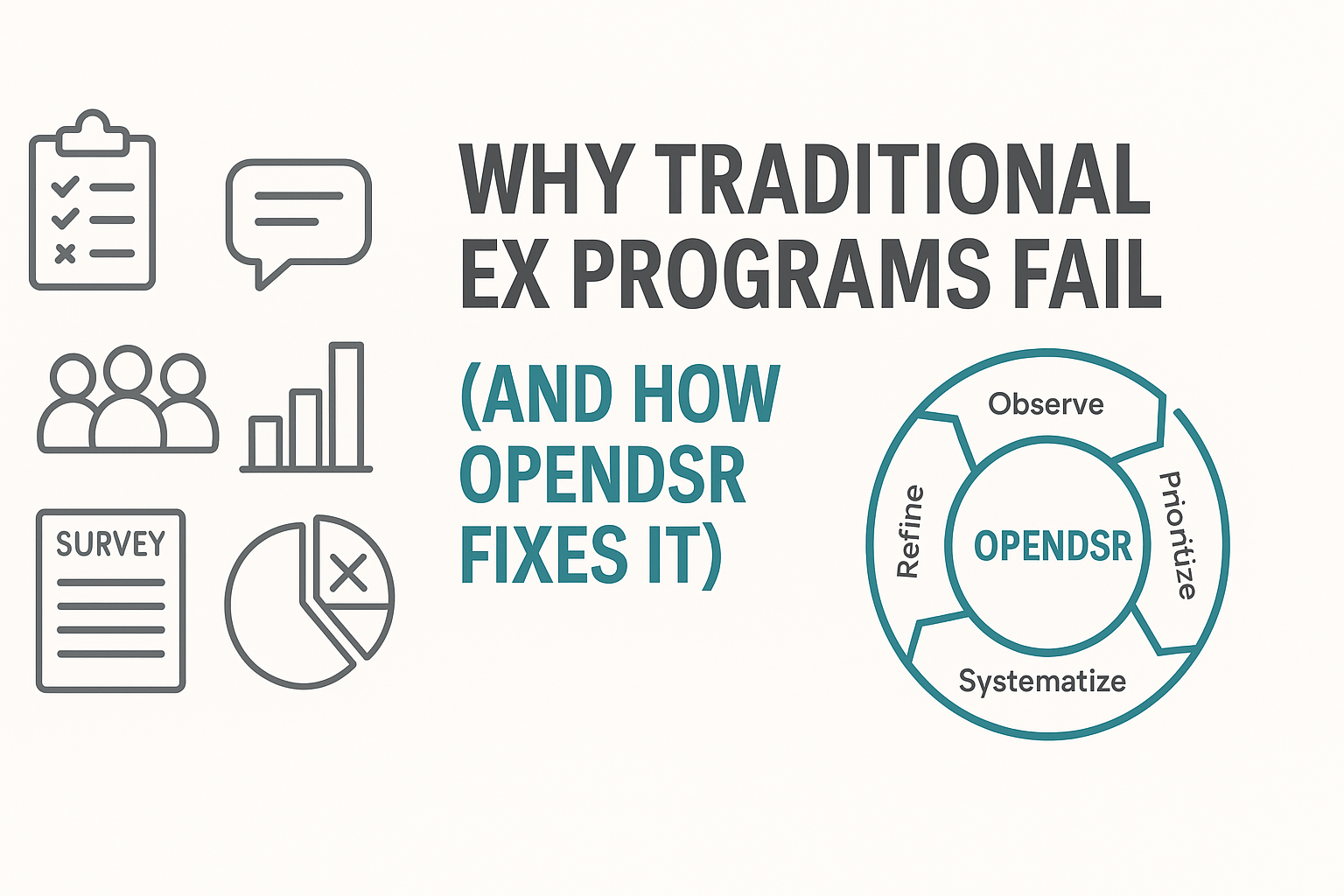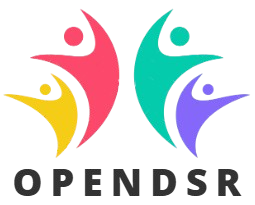
Why Traditional EX Programs Fail (and How OPENDSR Fixes It)
The Engagement Illusion
Over the past decade, organizations have invested heavily in employee experience (EX) programs. Millions have been spent on surveys, recognition apps, HR platforms, and well-being initiatives. And yet, results are mixed at best.
Consider the numbers: Gallup’s 2023 global survey revealed that only 21% of employees feel strongly engaged at work. McKinsey reports that 67% of employees feel unseen or unheard by their companies—even while budgets for “people programs” reach record highs.
The irony is stark. Leaders believe they’re investing in their people. Employees often feel the opposite. So where is the disconnect?
The answer lies in how traditional EX programs are built—and more importantly, how they fail.
Why Traditional EX Programs Fail
1. They Collect More Than They Create
Most EX programs start with surveys. Annual engagement surveys. Quarterly pulses. Feedback forms. Exit interviews. While useful in theory, in practice they become collection-heavy and creation-light.
Employees are asked to share opinions endlessly, yet little changes afterward. A survey might highlight that “manager communication is poor,” but unless that insight translates into redesigned team rituals or feedback loops, nothing improves.
Failure Pattern: Feedback becomes an extraction exercise rather than a design partnership. Employees stop contributing, response rates drop, and cynicism grows.
2. They Confuse Tools With Experience
When dissatisfaction surfaces, the knee-jerk reaction is often to buy a new tool—an engagement platform, collaboration suite, or recognition app. But technology doesn’t automatically equal experience.
Real employee experience is how people feel in the flow of work. It’s the tone of a manager’s feedback, the clarity of an onboarding process, the fairness of a promotion. Tools may support this, but when platforms are layered without integration, employees experience more friction, not less.
Failure Pattern: New systems feel like extra work. People must log in to yet another app, fill out yet another form, or learn yet another interface. Instead of improving experience, organizations accidentally worsen it.
3. They Operate in Episodic Bursts
Traditional EX programs are often cyclical: a big survey in Q2, a recognition campaign in Q4, a well-being week during Mental Health Month. These bursts create short-term excitement but rarely lasting change.
Employees don’t live in bursts. They live in daily rhythms—team meetings, project deadlines, performance reviews, and personal milestones. When EX programs ignore these micro-moments, they miss the heartbeat of real work.
Failure Pattern: Initiatives peak briefly, then fade. Employees perceive EX as a campaign, not a commitment.
4. They Focus on Data Lag, Not Real Time
By the time traditional programs flag a problem—through an annual survey or an exit interview—it’s often too late. Burnout has already spread, morale has dropped, and high performers have left.
Lagging data may satisfy reporting requirements, but it fails to prevent crises. Employees want to feel supported in real time, not studied months later.
Failure Pattern: Leaders become historians of disengagement rather than designers of belonging.
5. They Place Burden on HR Alone
Many EX initiatives are branded as “HR programs.” While well-intentioned, this framing isolates ownership. Managers assume HR will handle experience. Business leaders focus only on metrics. Meanwhile, employees continue to feel unsupported in the moments that matter most.
Failure Pattern: HR becomes the firefighter of culture, pulled in every direction with limited influence. Experience becomes a department, not a shared responsibility.
The Human Cost of Failure
When traditional EX programs fail, the impact is not abstract—it’s deeply human.
-
Silent disengagement: Employees stop sharing ideas, stop volunteering for stretch projects, and stop caring beyond the bare minimum.
-
Burnout cycles: Without real-time support, small stressors snowball into exhaustion.
-
Erosion of trust: People hear “we care” in town halls, but don’t feel it in daily interactions.
-
Attrition: Top talent leaves quietly, and exit interviews reveal issues that could have been fixed months earlier.
For organizations, the cost shows up in stalled projects, missed innovations, customer dissatisfaction, and ultimately—bottom-line losses.
Enter OPENDSR: A Different Way Forward
Traditional EX programs fail because they are episodic, tool-heavy, and reactive. OPENDSR offers a structured, rhythmic, and human-centered alternative.
OPENDSR stands for:
-
Open Platform – Embedding experiences directly into the tools employees already use.
-
Empathy-led Navigation – Sensing not just what’s said, but what’s signaled.
-
Design Standards – Ensuring equity and consistency in every experience.
-
Real-Time Intelligence – Acting while signals still matter.
Together, these pillars create an operating system for experience—not a one-off program.
How OPENDSR Fixes the Failures Fix #1: From Collection to Co-Creation
Instead of endless surveys, OPENDSR begins with observation and co-design. Employees aren’t just asked for feedback—they’re invited to shape solutions.
-
Observe: Capture real-time signals—Slack tone, participation dips, weekly check-ins.
-
Envision: Use co-design labs where employees map frustrations and propose improvements.
This turns feedback from an extraction mechanism into a design partnership. Employees see their voice in the final outcome, which boosts both trust and adoption.
Example: A manufacturing firm invited frontline staff into “experience labs.” They redesigned recognition rituals and shift handovers, increasing morale and productivity within weeks.
Fix #2: From Tools to Flow
OPENDSR avoids layering more platforms. Instead, it embeds experiences into existing flows.
-
Nudges inside Teams: “How’s your energy today?”
-
Templates in Slack: Exit reflection cards, onboarding checklists.
-
Ritual prompts in Outlook: 1:1 conversation guides.
By meeting employees where they already work, OPENDSR reduces friction and builds seamless, invisible support.
Example: A healthcare company added a one-line check-in to its daily Teams briefing. Participation jumped from 15% to 65% in one week—without introducing a new tool.
Fix #3: From Bursts to Rhythms
Instead of episodic campaigns, OPENDSR operates as a 7-step cycle: Observe → Prioritize → Envision → Navigate → Design → Systematize → Refine.
This rhythm ensures EX isn’t a quarterly event but a continuous loop. Small improvements stack into cultural shifts.
Example: A professional services firm introduced weekly “Listening Fridays.” Insights gathered on stress points reshaped Tuesday workloads, improving well-being scores in a single month.
Fix #4: From Data Lag to Real-Time Intelligence
OPENDSR closes the gap between signals and actions. Signals are surfaced, translated into insights, and acted upon within days—not quarters.
-
Signal: Slack silence, missed check-ins, tone changes.
-
Insight: Workload confusion, unclear goals, loss of trust.
-
Action: Adjust priorities, redesign rituals, clarify expectations.
Example: A sales team spotted stress signals in check-ins. Within 48 hours, unclear targets were clarified, workloads rebalanced, and morale restored.
Fix #5: From HR-Centric to Shared Ownership
OPENDSR reframes experience as a shared responsibility. Three new roles help distribute ownership:
-
EX Owner – Steward of overall experience integrity.
-
HCX Data Steward – Translator of feedback into action.
-
Moment Designer – Architect of everyday rituals.
These roles are not extra headcount but intentional hats worn across HR, managers, and business leaders. The result is an organization where everyone participates in shaping EX.
Example: A logistics company formed a triad—an HRBP, a shift supervisor, and an IT developer. Together, they co-designed mobile shift handover rituals. Attrition dropped, and trust rose by 34%.
Why OPENDSR Works
OPENDSR succeeds where traditional programs fail because it is:
-
Practical: Built into daily tools, not bolted on.
-
Rhythmic: Continuous, not episodic.
-
Inclusive: Designed with employees, not just for them.
-
Actionable: Prioritizes quick, visible moves over delayed reports.
-
Scalable: Standardizes equity while allowing local adaptation.
Most importantly, OPENDSR treats empathy as infrastructure—not as an optional soft skill. It operationalizes care.
The Tangible Benefits
Organizations applying OPENDSR report measurable improvements:
-
↑ Faster closure of feedback loops – Issues acted on within 30 days, not quarters.
-
↑ Trust and inclusion – Standardized rituals reduce inequity and increase belonging.
-
↑ Manager capability – Templates and nudges help leaders navigate tough conversations.
-
↓ Attrition – Real-time adjustments reduce the “silent suffering” that leads to exits.
-
↑ Business outcomes – Improved morale translates into productivity, innovation, and customer satisfaction.
A Call to Leaders
Traditional EX programs are not enough for today’s pace of change. Employees no longer wait patiently for quarterly surveys to be analyzed or annual plans to be rolled out. They decide daily whether their workplace is a place to stay, grow, and give their best.
OPENDSR offers leaders a way forward. Not by discarding technology or data—but by realigning them with human rhythms.
If you are an HR leader, stop thinking of yourself as a survey manager. Become a designer of belonging.
If you are a business leader, stop treating EX as separate from performance. It is performance.
If you are a technology leader, stop optimizing only for function. Start optimizing for feeling.
From Failure to Future
Traditional EX programs fail because they confuse motion for meaning. They measure but don’t move. They launch campaigns but don’t create rhythms. They buy tools but forget the human story.
OPENDSR fixes this by transforming EX into an operating system.
-
It listens continuously.
-
It prioritizes wisely.
-
It co-designs inclusively.
-
It navigates with clarity.
-
It designs with equity.
-
It systematizes for reliability.
-
It refines for resilience.
In doing so, OPENDSR doesn’t just improve employee experience—it makes work human again.
Because at the end of the day, people don’t stay for surveys or tools. They stay for trust, belonging, and purpose. And those are designed—not delivered.








